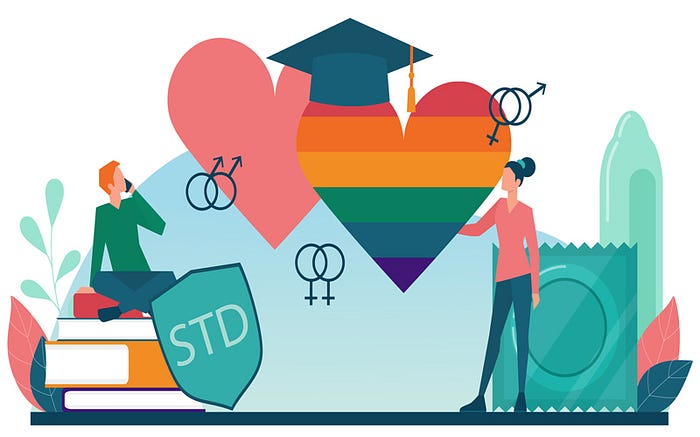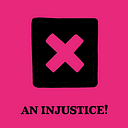Sex Ed For All
Building a more inclusive and understanding society

Breaking the taboo: Introducing inclusive sexual education
Today, we’re going to dive deep into the world of sex ed and explore why inclusivity is the way forward. Before we get into it, let’s first define what we mean by inclusive sexual education.
Inclusive sexual education is a comprehensive approach to teaching young people about sex and sexuality that is inclusive of all identities, orientations, and experiences. This means creating a safe and supportive environment that recognizes and respects the diversity of the student body.
So why is inclusive sexual education so important, you may ask? Well, the reality is that many young people today still face stigma and discrimination based on their sexual orientation, gender identity, or other factors. This can lead to feelings of shame, isolation, and confusion when it comes to sexuality.
By providing inclusive sexual education, we can empower young people with the knowledge and skills they need to make informed decisions about their bodies and relationships. It can also help reduce stigma and promote acceptance of all identities, leading to a more open and inclusive society.
And that’s where we come in. Our goal with this article is to break down the importance of inclusive sexual education and provide actionable steps for educators, policymakers, and advocates to take. So buckle up and get ready to learn, because we’re about to take this conversation to the next level.
The state of sex ed: Where we stand today
It’s time to talk about the state of sex ed in our schools and communities today. So, where do we stand?
Unfortunately, the reality is that many sexual education policies in the US are outdated and inadequate. The result is that many young people are not receiving the education they need to make informed decisions about their bodies and relationships.
But it’s not just a matter of lack of education, it’s also about lack of inclusivity. Many sexual education programs still fail to address the needs of LGBTQ+ students, students with disabilities, or students from diverse cultural backgrounds. This can leave these students feeling excluded and marginalized.
And the negative effects of this exclusion are clear. Research has shown that students who receive limited or no sexual education are at increased risk for unintended pregnancy, sexually transmitted infections (STIs), and sexual violence. Moreover, the lack of inclusivity can lead to feelings of shame, guilt, and confusion for students who do not see themselves represented in the curriculum.
So, where do we go from here? In the next sections, we’ll explore the benefits of inclusive sexual education and strategies for promoting it. Let’s work together to create a more inclusive and supportive environment for all young people.
The benefits of inclusive sex ed: Why it matters
Now that we’ve discussed the current state of sex ed and why inclusivity is important, let’s talk about the benefits of providing inclusive sexual education to young people.
First and foremost, inclusive sex ed can lead to improved health outcomes. By providing a comprehensive education that covers a range of topics, including consent, contraception, and STIs, young people are better equipped to make informed decisions about their sexual health and prevent unintended pregnancies and STIs.
But that’s not all. Inclusive sexual education can also increase understanding and acceptance of diverse sexual orientations, gender identities, and expressions. This can lead to a reduction in stigma and discrimination, creating a more inclusive and welcoming environment for all students.
Moreover, inclusive sex ed can enhance communication and relationship skills. By teaching young people about healthy communication, boundaries, and respect, they are better equipped to form healthy relationships and avoid negative experiences like sexual violence or coercion.
So, the benefits of inclusive sexual education are clear. It’s time to prioritize inclusivity and provide young people with the education and skills they need to make informed decisions about their bodies and relationships. Let’s create a world where all young people feel seen, heard, and supported.
Overcoming obstacles: Challenges to inclusive sex ed
Now, let’s talk about the challenges that stand in the way of providing inclusive sexual education to young people.
One major obstacle is resistance from parents and community members who may not be comfortable with certain topics being taught in schools. However, it’s important to recognize that inclusive sex ed is not about promoting any particular behavior, but rather about providing young people with accurate and comprehensive information about their bodies, relationships, and sexual health.
Another challenge is inadequate teacher training and resources. Many teachers may not have received adequate training in how to provide inclusive sex ed or may not have access to the resources they need to effectively teach the curriculum.
And let’s not forget political and religious opposition. Unfortunately, some politicians and religious groups actively oppose inclusive sexual education and may push for abstinence-only education or other forms of limited education. However, research has shown that abstinence-only education is not effective in preventing unintended pregnancies or STIs, and may actually harm young people by denying them important information about their bodies and relationships.
So, while there are certainly challenges to providing inclusive sexual education, it’s important that we continue to advocate for its importance and work to overcome these obstacles. All young people deserve access to accurate and comprehensive information about their bodies and relationships.
Programs that work: Examples of inclusive sex ed
Now that we’ve discussed the challenges to providing inclusive sexual education, let’s talk about some programs that are making it happen.
One example of inclusive sexual education is comprehensive sexuality education, which provides young people with accurate and comprehensive information about their bodies, relationships, and sexual health. This approach goes beyond simply teaching about abstinence or preventing STIs and instead covers a range of topics, including consent, healthy relationships, and gender and sexual diversity.
Another example is LGBTQ-inclusive sexual education. This type of education recognizes that young people who identify as LGBTQ may face unique challenges related to their sexual health and relationships and provides them with information and resources tailored to their needs. This can include discussing topics like gender identity and expression, as well as addressing issues like discrimination and stigma.
Finally, culturally sensitive sexual education recognizes that young people from different cultural backgrounds may have different attitudes towards sex and sexuality, and provides education that is respectful and sensitive to their cultural values. This can include addressing topics like family and relationships, as well as providing information about contraception and STI prevention.
These are just a few examples of the many types of inclusive sexual education programs that exist. By providing young people with education that is tailored to their needs and experiences, we can help them make informed decisions about their bodies and relationships, and create a more inclusive and supportive society for all.
Advocacy in action: Strategies for promoting inclusive sex ed
If we want to see more inclusive sexual education in our schools and communities, we need to take action and advocate for it. Here are some strategies for making that happen.
First off, we can engage with policymakers and education officials to ensure that they understand the importance of inclusive sexual education. This can include attending school board meetings or contacting elected officials to voice our support for comprehensive and inclusive sexual education.
We can also build community support by working with local organizations and community leaders. This can include partnering with LGBTQ organizations, youth groups, or faith-based organizations to help spread the message about the importance of inclusive sexual education.
Another important strategy is to support organizations that are already doing the work of promoting inclusive sexual education. This can include donating to or volunteering with organizations that provide comprehensive sexuality education, advocating for LGBTQ-inclusive policies, or working to address health disparities among marginalized communities.
By using these strategies and working together, we can help promote inclusive sexual education in our schools and communities and create a more inclusive and supportive society for all.
Busting myths: Separating fact from fiction in sex ed
It’s time to bust some myths about inclusive sexual education. There are a lot of misconceptions out there about what comprehensive and inclusive sex ed actually entails, so let’s take a moment to separate fact from fiction.
One common myth is that inclusive sexual education will lead to more sexual activity among young people. However, research has consistently shown that comprehensive sexuality education does not increase sexual activity or the frequency of sexual encounters. In fact, it can actually help young people delay sexual activity until they are ready, and make safer and healthier decisions when they do become sexually active.
Another myth is that LGBTQ-inclusive sexual education is inappropriate or promotes a certain lifestyle. In reality, LGBTQ-inclusive sex ed simply recognizes that LGBTQ youth exist and have unique needs and experiences that should be addressed in a comprehensive and respectful manner. Providing this education can help reduce bullying and discrimination against LGBTQ students, and promote a more inclusive and accepting school environment for all.
It’s also important to note that comprehensive sexuality education does not promote a particular set of values or beliefs. Rather, it provides students with accurate and age-appropriate information about sex and relationships and empowers them to make their own informed decisions.
By debunking these myths and sharing accurate information, we can help promote a better understanding of the importance of inclusive sexual education for all young people.
Best practices: Creating effective inclusive sex ed programs
Alright folks, let’s talk about the best practices for creating effective and inclusive sexual education programs. Inclusive sex ed programs are grounded in a few key principles, such as accuracy, age-appropriateness, cultural sensitivity, and respect for diversity. These principles ensure that all students receive an education that is relevant, respectful, and free from bias.
Successful inclusive sex ed programs also prioritize student-centred learning and participation. This means creating a safe and inclusive environment where students feel comfortable asking questions, expressing their opinions, and sharing their experiences. Programs that encourage active engagement and dialogue can help students develop critical thinking skills, enhance their self-esteem, and improve their overall well-being.
There are many great examples of successful inclusive sex ed programs out there. For instance, the FLASH (Family Life And Sexual Health) curriculum developed by Public Health Seattle & King County has been praised for its comprehensive and inclusive approach to sex ed, which includes lessons on healthy relationships, gender identity, and consent. Another example is the Be Real program in Australia, which focuses on promoting positive body image, self-esteem, and social skills in young people.
If you’re looking to create your own inclusive sex ed program, there are some important guidelines to keep in mind. These include consulting with students, parents, and community members to ensure that the program is relevant and culturally sensitive, providing adequate training and support for teachers, and using evidence-based curricula that are grounded in scientific research.
By following these best practices and guidelines, we can create more effective and inclusive sexual education programs that benefit all young people.
Toward a better future: New directions for inclusive sex ed
As society becomes more progressive and open-minded, it’s essential that our sexual education programs follow suit. This means continuing to push for inclusivity, diversity, and acceptance in all areas of sex ed.
One area that shows particular promise is the growing field of online sexual education. With more and more young people turning to the internet for information and advice, there’s a real opportunity to provide high-quality, accessible sex ed resources online. This could include interactive videos, online forums, and social media campaigns that promote healthy attitudes and behaviours.
Another exciting area of development is the use of technology in sex ed classrooms. From virtual reality simulations to educational apps, technology can help students engage with sex ed material in new and innovative ways.
Of course, there’s still much work to be done in terms of policy and legislation. We need to continue to advocate for comprehensive, inclusive sexual education programs that are accessible to all students, regardless of their background or identity. This means fighting against harmful policies that restrict or stigmatize certain groups, such as LGBTQ+ individuals or those with disabilities.
But with continued activism and advocacy, we can create a future where all young people have access to the knowledge and skills they need to make informed, healthy decisions about their bodies and their lives. So let’s keep pushing forward, together!
Take action: Resources for inclusive sex ed
Now that we have discussed the importance of inclusive sexual education, it’s time to take action. Here’s a summary of the key points we’ve covered:
- Inclusive sexual education is essential to promoting healthy relationships, reducing stigma and discrimination, and improving overall health outcomes.
- Current sexual education policies often lack inclusivity, which can lead to negative consequences for young people.
- There are challenges to implementing inclusive sexual education, including resistance from parents and community members, inadequate teacher training and resources, and political and religious opposition.
- Despite these challenges, there are successful programs and best practices that can guide the creation and implementation of inclusive sexual education programs.
- Advocacy and activism are important for promoting inclusive sexual education, including engaging with policymakers and education officials, building community support, and supporting inclusive sexual education organizations.
To continue the conversation and promote change, we recommend the following resources:
- Advocates for Youth: A national organization that champions efforts to promote inclusive sexual education and sexual health for young people.
- Planned Parenthood: An organization that provides education and healthcare services related to sexual and reproductive health.
- The Sexuality Information and Education Council of the United States (SIECUS): An organization that advocates for comprehensive sexual education and provides resources for educators, parents, and policymakers.
- Scarleteen: An online resource that provides comprehensive, inclusive, and non-judgmental sexual education and support for young people.
- “Teaching Sex Ed: 6 Key Concepts for Effective Curricula” by Elizabeth Schroeder and Laura M. Jiménez: A book that provides guidance on creating and implementing effective sex education programs.
- The National Sexuality Education Standards: A set of guidelines developed by SIECUS and other organizations that outline the essential components of comprehensive sexual education.
- The Sex Ed Library: A resource that provides access to peer-reviewed sexual education research and publications.
By using these resources, we can continue to promote inclusive sexual education and work toward a future where all young people have access to the information and resources they need to make healthy decisions about their bodies, relationships, and sexual health.
Thanks for reading! If you enjoyed this article, please follow me on Twitter, Patreon, and Mastodon at @AsInTheJar. As a Canadian DEI communicator, I share insights and perspectives promoting diversity, equity, and inclusion.If you found this article helpful and entertaining, please give it a round of applause by clicking the clap button. Holding the clap button down for 30 seconds will give me 50 claps and make my day!Remember, sharing is caring, so please share this article with your friends and leave a comment below to let me know what you thought. Your feedback and support mean a lot to me. Until next time, keep on clapping and following me at @AsInTheJar!










